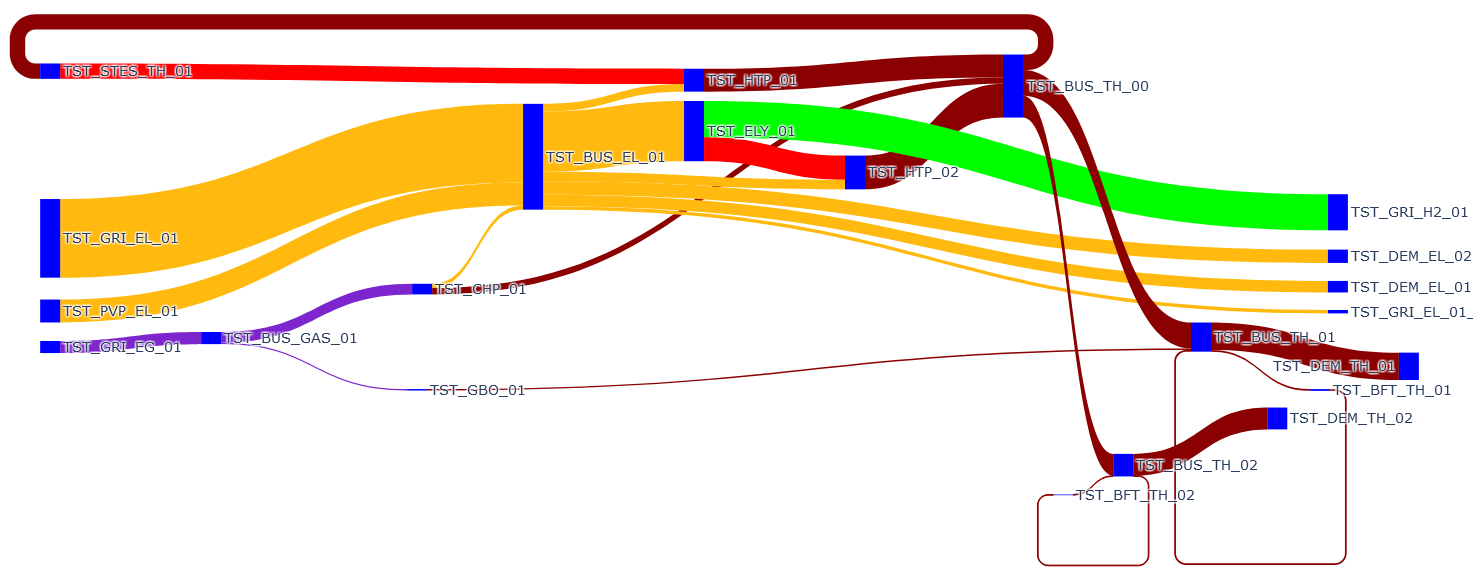Exemplary energy systems
In this chapter, some exemplary energy systems will be described and discussed. This may help to understand the capabilities, limitations and usage of ReSiE.
For all examples the required input files are shipped together with ReSiE as JSON files in the subdirectory examples. The project files may link to profile files (as .prf), which are also shipped alongside ReSiE in the profiles subdirectory. The examples can be executed with
julia --project=. src/resie-cli.jl examples/name_of_example.json
in the ReSiE directory. The outputs are written to the output subdirectory by default. Please note that output files from multiple simulation runs (including different examples) are not deleted, but are overwritten.
All examples will produce an interactive plot of interesting result data (default output/output_plot.html) and a sankey plot of yearly sums of energy (default output/output_sankey.html). You can customize both plots as described in the chapter on the input file format. The log files (default output/logfile_general.log and output/logfile_balanceWarn.log) are of interest as well, particularly if the example generates warnings on purpose.
Minimal example of a heat pump
File: examples/simple_heat_pump.json
A fairly minimal example of operating a heat pump to supply a heat demand by using electricity from the grid and a heat source. The heat source provides temperatures in the range of 19 °C to 27 °C. The demand takes in heat at temperatures varying from 49 °C to 66 °C. The heat pump works with a fixed COP of 3.0.
This example demonstrates how an energy system with a heat pump can be structured on a basic level. Heat pumps are an important and versatile component, however also provide some modelling challenges in combination with other components that handle heat in a complex way. Therefore this example is a known baseline from which energy systems using a heat pump can extend.
For a slightly more advanced version you can remove the line "constant_cop": 3.0 from the subconfig of the heat pump. The varying temperatures of input and output are then considered in a simplified Carnot-efficiency calculation and result in a dynamic COP.
District with sector coupling
File: examples/multisector_district.json
This example demonstrates complex behaviour of an energy system covering multiple sectors over the span of a year. Heating and electricity demands in two different subdivisons (e.g. for two groups of buildings) are supplied with a variety of producers. Interesting components include a hydrogen electrolyser feeding into a hydrogen grid and a seasonal thermal energy storage.
This example is also discussed in depth in Ott20231, however the results discussed in the publication are based on the simplified component models from the time of publication. The example file in the ReSiE repository will use the currently implemented models, therefore results may differ.
The following figure shows a sankey plot of the yearly sums of energy. All components play a role in the operation of the energy system to different degrees, which can be seen by following the flow of energy in the plot.

The example has also been set up in a specific way such that the energy balance is not upheld in every time step. For a few hours distributed over the span of the year, the heating demand 2 is not fully met. This can happen because there is no source of heat in the energy system which can produce an arbitrary amount of heat without possibly being limited by an input or output. The CHP comes close, but fails to cover peaks in demand when the buffer tanks are empty as it is not sufficiently sized for peak load coverage. The gas boiler does act as peak load supplier, but is connected only to heating demand 1.
-
Ott, E.; Steinacker, H.; Stickel, M.; Kley, C. and Fisch, M.N.: Dynamic open-source simulation engine for generic modeling of district-scale energy systems with focus on sector coupling and complex operational strategies, 2023, Journal of Physics: Conference Series 2600, 022009 ↩